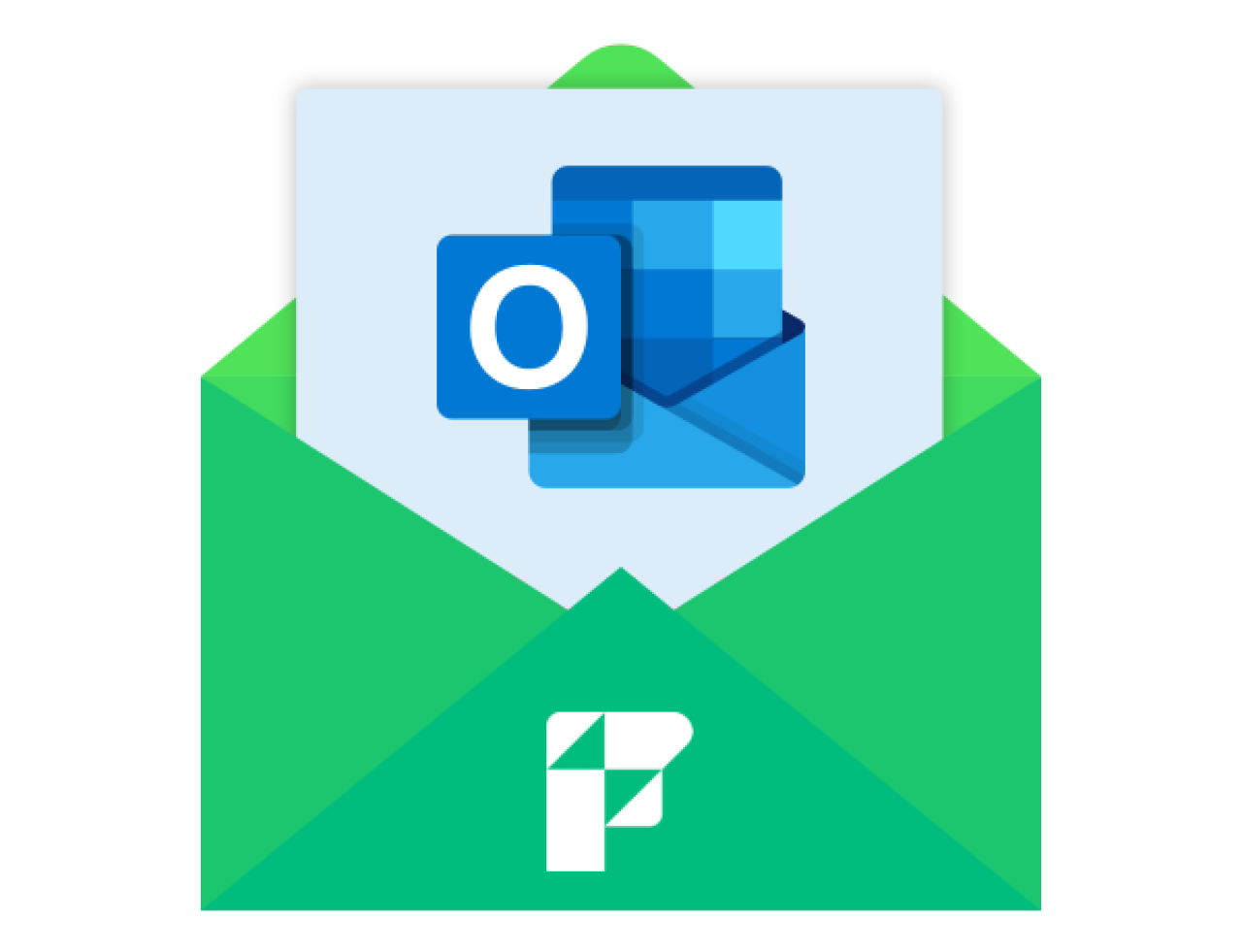
Welcome, and congratulations to you for taking a step toward customer service nirvana with Salesforce Service Cloud! As you may know, Salesforce Service Cloud is a platform containing powerful tools that enable you to manage service interactions with your customers, build versatile automations, and utilize reports and dashboards to track the effectiveness of your implementation. The breadth of tools and configurations that Service Cloud offers is expansive, which promotes customizability. But it may also leave you wondering, “Where do I begin?” This guide will provide you with an overview of the information and best practices you will need to build a successful implementation.

Set Up and Manage Cases
Cases are the primary tools that your service teams will use to interact with your customers. Consequently, ensuring that they have been appropriately configured will provide a solid foundation on which to build your implementation. Additionally, cases and case management practices directly influence customer satisfaction.
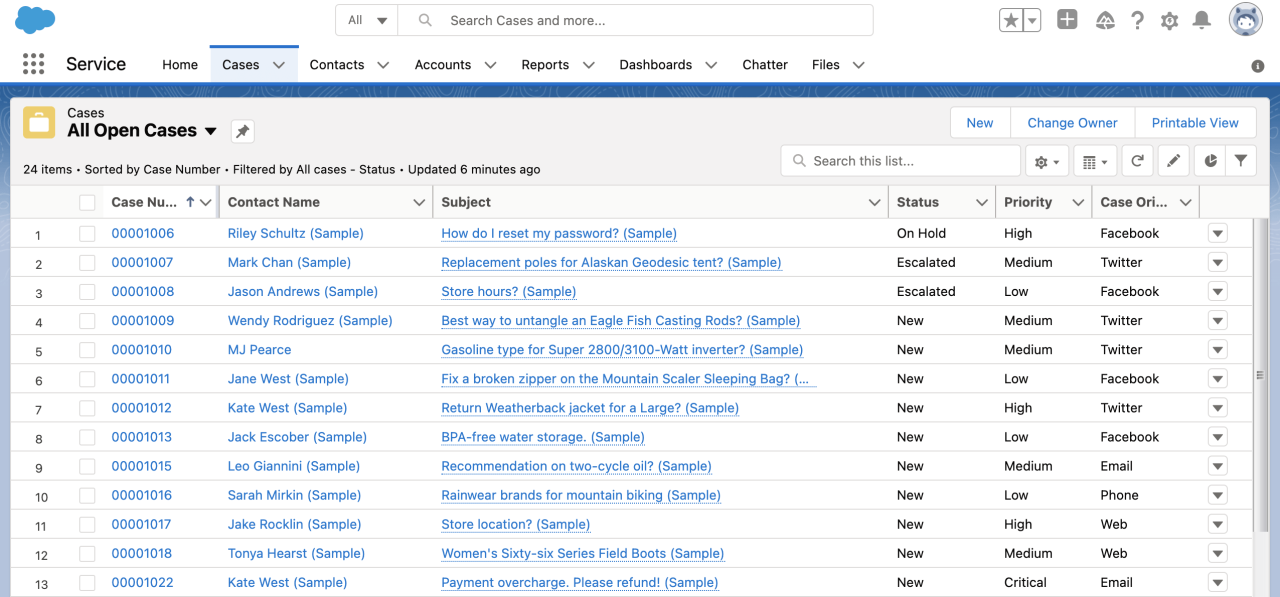
In your case management toolbox, you will find:
Case teams – Allows groups of people to work together to solve cases
Queues – Queues can be used to hold inbound cases without an owner so that team members who share workloads can take ownership and process them as they are created.
Assignment rules – Allow cases to be routed to users or queues specified by attribute criteria
Auto-response rules – For inbound emails, a criteria-dependent auto-response can be sent before a service agent’s follow-up.
Escalation rules – Rules may be defined to escalate certain cases based on criteria such as priority, case type, or response time.
Service-Level Agreements
In order to best serve your clientele, a standard of service is often utilized to ensure adequate attention is provided to each case that is created. Service-level agreements allow you to define a commitment of service you have made to your customer, implicitly or explicitly. Through service contracts, entitlements, milestones, and assets, you will find a comprehensive approach to managing SLAs.
Productivity Tools
Once a service process and case layout have been defined, you may become aware of repetitive tasks or opportunities for automation that your service agents would love to implement when it comes to interacting with cases. Service Cloud contains a multitude of time-saving tools to address these issues. Here are a few of the most helpful ones:
Quick Text – As simple as it sounds, quick text is a predefined message or phrase that a user can insert into emails, chats, and other mediums to improve response times.
Macros – Macros allow you to define a set of instructions to tell the system how to process a certain task. For repetitive tasks that require the same method of execution, such as answering a customer inquiry, a macro can select an email template, send an email, and update the case status with one mouse click.
Mass Quick Actions – Users may use mass quick actions to edit or update up to 100 records from any list view.
Split View – This allows users to open a collapsible list view while also viewing record details.
Email Templates – A template allows for standardization of responses that can utilize case-specific details such as contact name or case subject. You can either define emails to be sent automatically or customize the email before it is sent.
Omni-Channel Routing
One of Service Cloud’s most valuable features is the Omni-Channel, a tool that enables you to configure routing rules to assign work to agents based on availability and skill set. It can serve as a communication hub for multiple channels of interaction and ensure that your customer service team is working at an optimal level.
Additionally, it allows managers to easily monitor the number of work items assigned to agents and the status of cases routed by the Omni-Channel. Chat and voice transcripts are updated in real time, and managers can use them to provide support to agents through messages or respond to requests from agents when assistance is required.
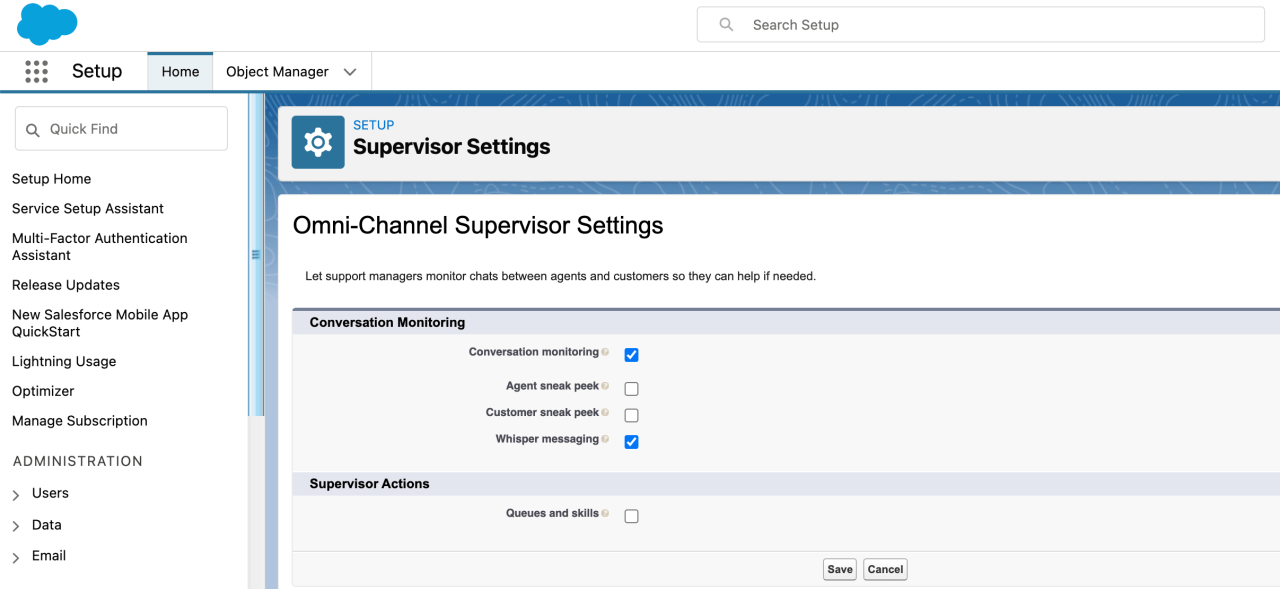
Service Cloud Channels
Service Cloud is capable of capturing customer interactions across a wide variety of channels including email, phone, webchat, social networks, community portals, and more. Case creation automation tools, such as screen flows for phone calls and email-to-case, make it easy to update, interact, and manage service requests so that agents can spend more time solving issues and less time clicking through screens.
After all, the value proposition of a CRM service solution is to provide the best service through flexibility to communicate with your customers and easily gather all the important information from every interaction.
Salesforce Knowledge
Salesforce Knowledge gives you a repository to store and share knowledge articles with visitors to your website, customers, partners, or service agents. Knowledge articles are documents that may contain any variety of useful information you would want to share, such as an FAQ or a step-by-step walkthrough. In addition to knowledge articles, Chat Answers allow your service agents to use the Knowledge Base to answer customer inquiries and embed articles right in the chat session. With the use of Data Categories, articles can be organized and grouped by defined criteria and allow for controlled access so that only the right people are able to view certain documents.
Einstein for Service
One of the most exciting features of Service Cloud is Einstein for Service, a collection of tools that utilizes AI and intuitive recommendations to aid customers and service agents.
Einstein Bots – Bots are a great way to reduce the number of low complexity requests to your service agents. They can be configured to handle routine inquiries from your customers and can escalate more complex issues to a service agent if needed.
Einstein Classification Apps – This incredibly useful tool can be utilized to automatically fill certain case fields based on historical case data, recommending or selecting values so that your agents can focus their attention on the conversation. For chat sessions, agents are shown recommended or selected values based on chat interactions with Einstein Case Wrap-Up.
Einstein Article Recommendations – Agents may be given article recommendations based on chat communications to quickly and sufficiently answer cases.
Einstein Reply Recommendations: Easily craft replies to customer chat messages that standardize messaging to customers, free up your agents, and speed up case resolution time.
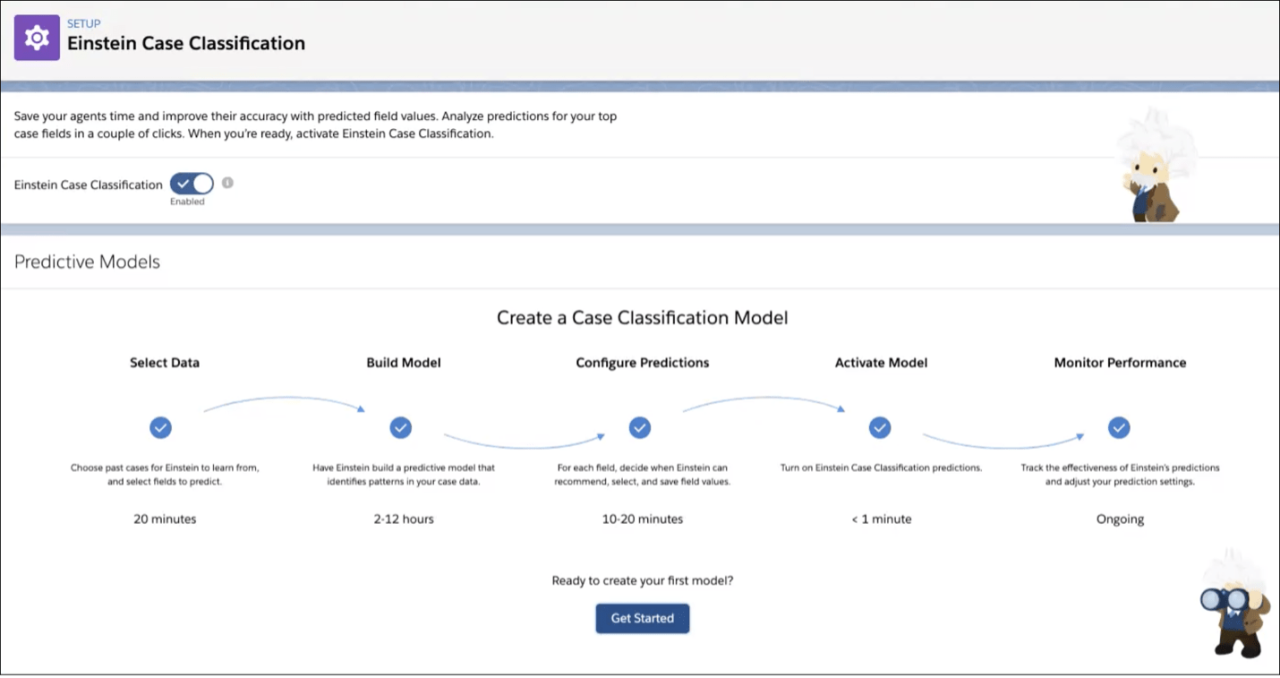
Security
Ensuring that confidential or sensitive information remains secure is incredibly important, and Salesforce's data security features allow for custom access for each user. With Sharing Settings, Roles, Profiles, Permission Sets, and Field-Level Security, you can control access from the highest to the lowest levels of your organization's data structure.
Sharing Settings - With Sharing Rules you can automatically open up access to users at the record level by defining which records get shared with certain users based on record criteria. Manual sharing enables users to ad hoc share records with users that may not have read or edit access through other permissions.
Roles - By utilizing roles and a role hierarchy, you can open up access to record-level data based on your own organization's hierarchy. For example, you can allow managers to have access to records owned by their subordinates.
Profiles - Profiles determine what permissions a user has to view or interact with data at the object level, such as create, read, edit, and delete.
Permission Sets - Permission sets allow you to grant additional object-level access to a definable subset of users that may or may not share the same profile.
Field Level Security - At the most granular level of object-level security, field-level access enables you to give profiles or permission sets access to individual fields within an object.
Reporting and Dashboards
Service Cloud support reports and dashboards give supervisors a comprehensive picture of their service team's output and can highlight opportunities for process improvement with data-driven insights. Reports can track statistics such as the number of cases created, case comments, emails, case owners, contact roles, response time, and any other important case data. Dashboards allow you to visualize report data and can give you an at-a-glance service health check.
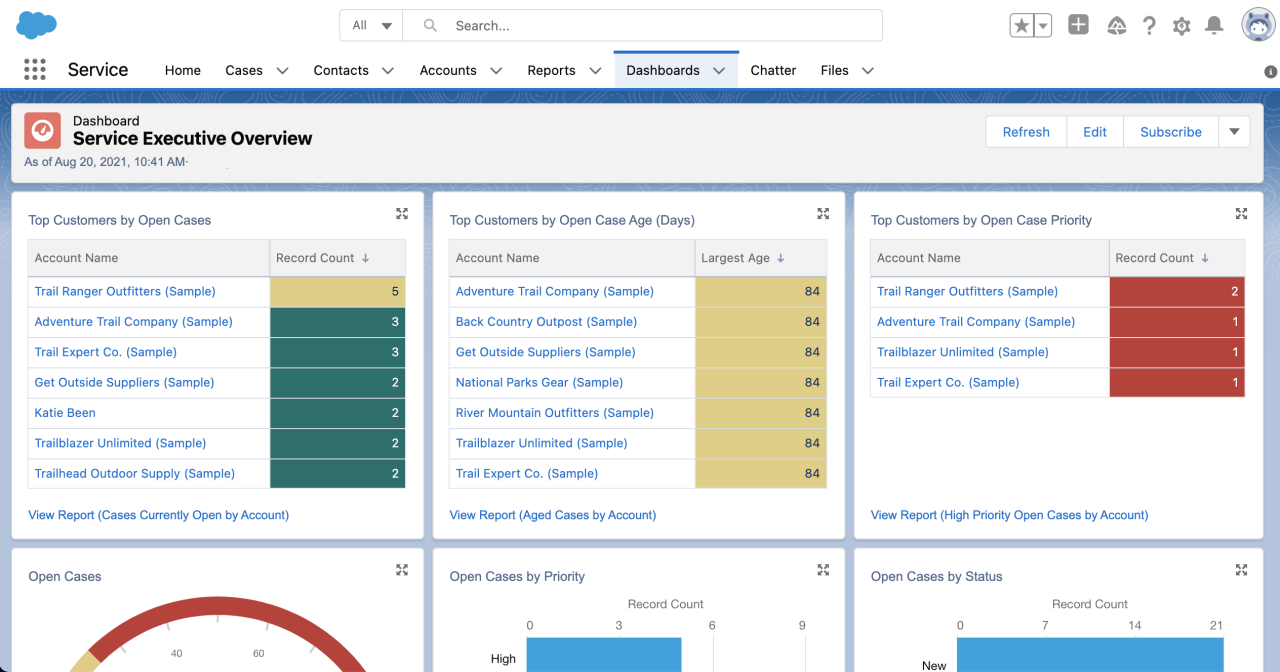
Data Migration
If you require an import of existing case or service data into your implementation, Salesforce features a couple of data migration options to suit your needs. The Import Wizard is ideal when loading less than 50,000 records at a time and allows you to avoid duplicate record creation. The Data Loader is capable of loading up to 5,000,000 records at once and offers a command-line interface for performing automated operations.
System Integrations
As with many businesses who use Salesforce, it may not be the only system that is a part of your service process. Should you require integration with an existing ERP or service platform, there are a number of solutions you can leverage to connect them to Salesforce Service Cloud. This provides you the ability to share records between systems and perform useful automation, which can help streamline processes and provide a seamless customer experience.
Salesforce AppExchange boasts a robust library of premade integration packages that you can easily install in your org. Alternatively, if an out-of-the-box option won't cut it, an implementation team such as DB Services can help you build a bespoke integration solution that meets your specific needs.
Time to Build Your Best Service Platform
The possibilities for exceptional customer service and operational efficiency are nearly endless when considering all the offerings in Salesforce Service Cloud. And with a comprehensive understanding of your business and service processes, a tailored Service Cloud can provide incredible value to you and your customers to build relationships that reach beyond the context of customer service. Contact DB Services for any questions you have or if you need assistance building your best service platform in Service Cloud!
Need help with your Salesforce digital transformation? Contact us today to discuss Salesforce consulting, implementation, development, and support!
Download the Salesforce Service Cloud Implementation Checklist
Please complete the form below to download your FREE Salesforce file.





